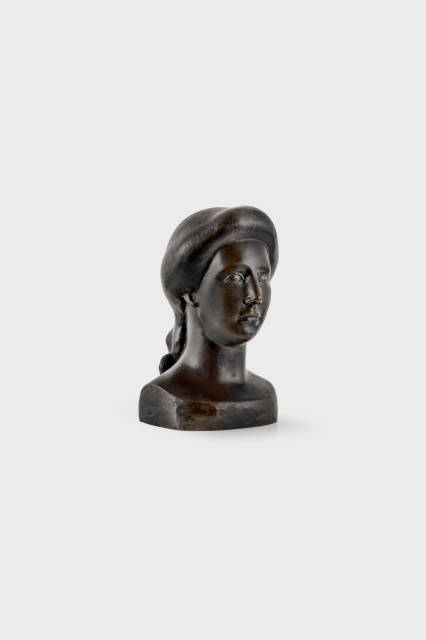- EN
Log in
- Live Auctions
- Past auctions
- More
- Gallery
- Art Dealing
- Publishing
- Kornfeld today
- The Story of Kornfeld
- Information






1861 Banyuls-sur-Mer 1944
Sale time 13-09-2024,
about 17:15 h (CET)
(+/- 30 min)
1910-1911, cast during the artist's lifetime
Bronze
37.5x24.1x25.4 cm
Monogrammed in an oval "M", with the number "No 1" stamped twice next to it and with the foundry mark "Cire / C. Valsuani / Perdue"
Kraushaar Galleries, New York (from 1929), acquired there in 1939 from
Collection Abby Aldrich Rockefeller, New York, labelled inside, from there in 1939 as an anonymous gift to the
Museum of Modern Art, New York, inv. no. 599.1939
The Bulletin of the Museum of Modern Art, New York April 1940, Vol. 7, No. 1, p. 2
Published in the collection catalogues "Painting and Sculpture in The Museum of Modern Art" in 1942, p. 390, 1948, p. 470, 1977, p. 59, 1988, p. 73
New York 1933, Museum of Modern Art, Summer Exhibition: Painting and Sculpture
New York 1937/1938, Museum of Modern Art, Transitions and Contrasts in Painting and Sculpture
Baton Rouge/Williamstown/Lawrenceville/Exeter/Wallingford 1939/1940, University of Louisiana/Williams College/The Lawrenceville School/The Phillips Exeter Academy/The Choate School, Three Bronze Portraits
New York 1940/1941, MoMA, Painting and Sculpture from the Museum Collection
With wonderful patina and finely chiselled surface, minimal traces of use
Aristide Maillol created four large-format figures for the music hall of his Moscow city palace for the Russian collector Ivan Morozov in 1909-1912: "Pomona", "Spring", "Summer" and "Flora". These are allegorical figures, but their respective attributes have been greatly reduced; the artist dispensed with traditional iconography. In "Flora", only the beginnings of a garland of flowers are visible. Once again, Maillol's aim was to simplify his figures in a form of classical rigour, which accounts for his incomparable modernity in sculpture. As Maurice Denis said with regard to the cycle, the artist possessed the gift of condensing the infinite manifestations that we perceive in nature into a clear and concise form.
In addition to the large-format full-length figure, he also created a bust of "Flora", which is limited to the head and the base of the shoulders. This figure on offer here also dispenses with all attributes. This makes "Flora" the epitome of classical reduction in Maillol's oeuvre, which still touches viewers immensely today. Only very few examples of this version of "Flora" are known to exist, for example in the Kröller-Müller Museum in Otterlo or in a private collection. Ursel Berger points out that Maillol initially worked the surfaces of his bronzes with a file. The present work is wonderfully filigree.
Property of the Museum of Modern Art, New York
1910-1911, zu Lebzeiten des Künstlers gegossen
Bronze
37,5x24,1x25,4 cm
Monogrammiert im Oval "M", daneben zweifach mit der gestempelten Nummer "No 1" und mit dem Giesserstempel "Cire / C. Valsuani / Perdue"
Kraushaar Galleries, New York (ab 1929), dort 1939 erworben von
Slg. Abby Aldrich Rockefeller, New York, innen mit Etikett, von dort 1939 als anonymes Geschenk an das
Museum of Modern Art, New York, Inv. Nr. 599.1939
The Bulletin of the Museum of Modern Art, New York April 1940, Vol. 7,
Publiziert in den Sammlungskatalogen "Painting and Sculpture in The Museum of Modern Art" in den Jahren 1942,
New York 1933, Museum of Modern Art, Summer Exhibition: Painting and Sculpture
New York 1937/1938, Museum of Modern Art, Transitions and Contrasts in Painting and Sculpture
Baton Rouge/Williamstown/Lawrenceville/Exeter/Wallingford 1939/1940, University of Louisiana/Williams College/The Lawrenceville School/The Phillips Exeter Academy/The Choate School, Three Bronze Portraits
New York 1940/1941, MoMA, Painting and Sculpture from the Museum Collection
Mit wunderbarer Patina und fein ziselierter Oberfläche, minime Gebrauchsspuren
Aristide Maillol schuf 1909-1912 für den russischen Sammler Iwan Morosow vier grossformatige Figuren für den Musiksaal seines Moskauer Stadtpalais: "Pomona", "Frühling", "Sommer" und "Flora". Es handelt sich um allegorische Figuren, deren jeweilige Attribute jedoch stark reduziert wurden; der Künstler verzichtete auf die tradierte Ikonographie. Bei "Flora" ist bloss der Ansatz einer Blumengirlande sichtbar. Einmal mehr ging es Maillol darum, seine Figuren in einer Form klassischer Strenge zu vereinfachen, was seine unvergleichliche Modernität in der Plastik ausmacht. Wie Maurice Denis sinngemäss mit Blick auf den Zyklus äusserte, besass der Künstler die Gabe, die unendlichen Erscheinungsweisen, die wir in der Natur wahrnehmen, zu einer klaren und konzisen Form zu kondensieren.
Neben der grossformatigen Ganzfigur entstand von "Flora" auch eine Büste, die sich auf den Kopf und den Schulteransatz beschränkt. Auch bei dieser hier angebotenen Figur wurde auf alle Attribute verzichtet. Das macht "Flora" zum Inbegriff der klassischen Reduktion in Maillols Schaffen, die die Betrachtenden noch heute ungemein berührt. Nur sehr wenige Exemplare dieser Fassung von "Flora" sind bekannt, etwa im Kröller-Müller Museum in Otterlo oder in einer Privatsammlung. Ursel Berger weist darauf hin, dass Maillol am Anfang die Oberflächen seiner Bronzen mit einer Feile bearbeitet hat. Die vorliegende Arbeit ist wunderbar filigran ausgearbeitet.
Eigentum des Museum of Modern Art, New York
Property from The Museum of Modern Art, New York
| Switzerland | CHF | Individual offer |
| Europe | CHF | Individual offer |
| Overseas | CHF | Individual offer |







